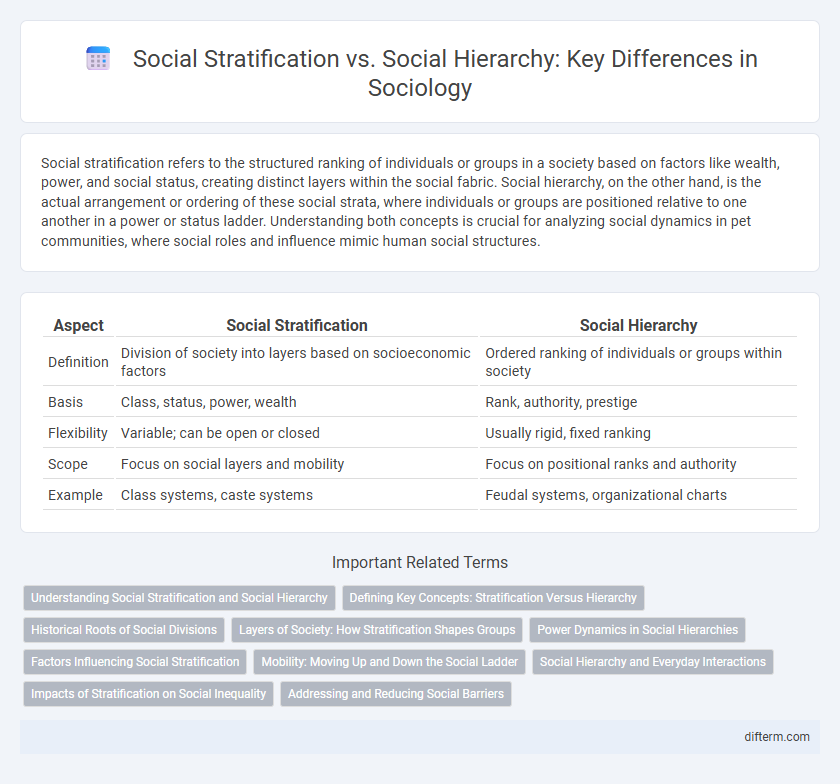Social stratification refers to the structured ranking of individuals or groups in a society based on factors like wealth, power, and social status, creating distinct layers within the social fabric. Social hierarchy, on the other hand, is the actual arrangement or ordering of these social strata, where individuals or groups are positioned relative to one another in a power or status ladder. Understanding both concepts is crucial for analyzing social dynamics in pet communities, where social roles and influence mimic human social structures.
Table of Comparison
| Aspect | Social Stratification | Social Hierarchy |
|---|---|---|
| Definition | Division of society into layers based on socioeconomic factors | Ordered ranking of individuals or groups within society |
| Basis | Class, status, power, wealth | Rank, authority, prestige |
| Flexibility | Variable; can be open or closed | Usually rigid, fixed ranking |
| Scope | Focus on social layers and mobility | Focus on positional ranks and authority |
| Example | Class systems, caste systems | Feudal systems, organizational charts |
Understanding Social Stratification and Social Hierarchy
Social stratification refers to the systematic ranking of individuals or groups based on factors such as wealth, power, and social status, creating distinct social layers within society. Social hierarchy emphasizes the structured organization of these layers, highlighting authority and control relationships among different social positions. Understanding these concepts reveals how resources and opportunities are distributed unevenly, shaping social dynamics and individual experiences.
Defining Key Concepts: Stratification Versus Hierarchy
Social stratification refers to the structured ranking of groups in society based on factors such as wealth, power, and prestige, creating distinct social layers. Social hierarchy, on the other hand, emphasizes the relative position of individuals within these layers, illustrating how authority and status are distributed. Understanding the distinction between these concepts is essential for analyzing patterns of inequality and social organization.
Historical Roots of Social Divisions
Social stratification and social hierarchy both stem from historical foundations rooted in economic, political, and cultural divisions that structured societies into distinct classes or ranks. Ancient civilizations such as Mesopotamia and Egypt established rigid social layers based on birthright, occupation, and wealth, embedding inequality into legal and religious systems. These early frameworks laid the groundwork for modern social divisions, influencing class systems, caste distinctions, and power dynamics observable in contemporary societies worldwide.
Layers of Society: How Stratification Shapes Groups
Social stratification organizes society into distinct layers based on factors like wealth, power, and prestige, creating a systemic ranking of groups that influences access to resources. Social hierarchy represents these layers as a structured order of dominance and subordination, reflecting inequality and social roles. Together, stratification and hierarchy define the boundaries and interactions between social groups, shaping opportunities and social mobility.
Power Dynamics in Social Hierarchies
Power dynamics in social hierarchies shape access to resources, influence, and decision-making authority across different social strata. Unlike social stratification, which categorizes individuals based on class, status, or economic position, social hierarchies emphasize the relational aspect of power and control within societal institutions. Understanding these power relations reveals how dominance and subordination reproduce social inequalities and maintain systemic privilege.
Factors Influencing Social Stratification
Social stratification is shaped by factors such as economic status, education, occupation, and power, which determine individuals' social positions and access to resources. Social hierarchy reflects the structured ranking within society, influenced by cultural norms, historical contexts, and institutionalized inequalities. These factors collectively sustain and reproduce patterns of social inequality across generations.
Mobility: Moving Up and Down the Social Ladder
Social stratification refers to the structured inequality between different social groups based on factors like wealth, education, and occupation, while social hierarchy denotes the ranking of individuals or groups within that system. Mobility in social stratification measures the ability of individuals or families to move up or down the social ladder, influenced by education, economic opportunities, and social policies. High social mobility indicates a more fluid society where class boundaries are less rigid, whereas low mobility reinforces entrenched social inequalities.
Social Hierarchy and Everyday Interactions
Social hierarchy structures daily interactions by determining individuals' access to resources and social privileges based on ranked positions. This ranking system influences communication patterns, power dynamics, and societal roles within communities. Understanding social hierarchy reveals how implicit statuses shape behavior and reinforce social order in everyday life.
Impacts of Stratification on Social Inequality
Social stratification creates structured layers within society that often determine access to resources, opportunities, and privileges, leading to unequal social outcomes. This division based on factors like class, race, and gender perpetuates disparities in wealth, education, and power, reinforcing systemic social inequality. The resulting social hierarchy solidifies these divisions, making upward mobility difficult and sustaining persistent social exclusion for marginalized groups.
Addressing and Reducing Social Barriers
Social stratification categorizes individuals into layered groups based on socioeconomic status, power, and prestige, while social hierarchy emphasizes the ranked ordering within these layers. Addressing and reducing social barriers involves promoting equitable access to education, healthcare, and economic opportunities, which dismantles rigid class distinctions and fosters social mobility. Implementing community-based programs and inclusive policies enables marginalized groups to overcome systemic constraints inherent in traditional social hierarchies.
social stratification vs social hierarchy Infographic

 difterm.com
difterm.com